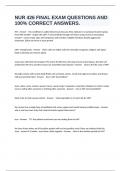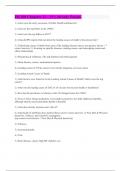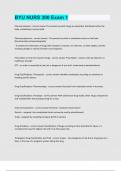NUR 426 FINAL EXAM QUESTIONS AND
100% CORRECT ANSWERS.
HIV - Answer this conditions is called retroviruses because they replicate in a backward manner going
from RNA to DNA-- targets the CD4+ T cell and binds through cell fusion using reverse transcriptase
enzyme-- causes major signs and symptoms and includes multiple infections despite aggressive
treatment, failure to thrive or poor growth
CD4+ t lymphocyte - Answer these cells are helper cells the normally recognizes antigens and signal
body to develop an immune attack
virus fuses with CD4 cell receptor, HIV inserts its RNA into cell using reverse transcriptase, the CD4 cell
synthesizes HIV virus and the viruses are assembled and released - Answer what is the life cycle of HIV?
through contact with certain body fluids such as blood, semen, rectal and vaginal secretions and breast
milk and amniotic fluid - Answer how is HIV transmitted?
tears, saliva, urine, emesis, sputum, feces, sweat, bugs/ mosquitos, respiratory droplets or enteric routes
such as eating after someone or drinking after someone - Answer how is HIV not transmitted?
black male to male sexual contact - Answer what population is at most risk for HIV?
the rectum has a single layer of epithelial cells versus vagina and mouth having multiple layers - Answer
why is anal sex more risky than male to female vaginal intercourse?
true - Answer T/F: the patient must know you are testing them for HIV
the time frame where an HIV positive patient will not test positive even if they are infected with the
virus-- around 2-3 weeks-- may show a false negative - Answer what is the window period for HIV?
,enzyme linked immunosorbent assay (ELISA) test or 4th generation HIV antibody antigen test-- the
antigen will turn positive after day 13-- the antibody will turn positive around day 30 (2-6 weeks) -
Answer what test is recommended for HIV testing? how does it work?
HIV viral load test (NAAT) - Answer if the 4th generation HIV antibody antigen test turns positive, what
test is used to follow up?
CD4 monitoring at 3 weeks, 3 months and 6 months of treatment-- goal is 800-1500 cells/mm3-- viral
load is monitored every 6 months - Answer how is HIV monitored?
reveal the news in person, beneficial to bring a support person if possible, draw follow up labs at first
visit, explain treatment plan at next visit so they have time to cope and fully understand their options -
Answer how do we tell a patient that they are HIV positive?
true - Answer T/F: a patient who takes their HIV medications daily and obtains an undetectable viral
load will not transmit the virus through sex and live a normal lifespan
stage 0 - Answer this stage of HIV is early infection-- the pt has just been exposed-- may experience flu
like symptoms such as rash, fever, muscle/ joint pain, fatigue, sore throat, headache, swollen lymph
nodes-- the disease is highly contagious at this point and viral load is high
stage 1 - Answer this stage of HIV is the acute infection to the development of antibodies where the
destruction of CD4 T cells drops the t cell count-- other immune cells increase to attempt to kill off virus--
may develop into a chronic persistent phase where the body cannot rid the virus-- may last 8-10 years
and is fairly asymptomatic
viral set point - Answer this is the set point the body settles at within a few weeks to months after
infection with HIV. the body is killing off HIV at a similar rate to replication--physicians look at this and if
viral load is still high, pt have poorer prognosis because the body is not ridding the virus
stage 2 - Answer this stage of HIV occurs when the T lymphocyte count is between 200-499--
symptoms resurface due to drop in immune fighting cells
, stage 3 - Answer this stage of HIV occurs when t lymphocyte counts are less than 200 cells/mm3 of
blood. Pt are considered to have AIDS for surveillance purposes and may receive disability, benefits,
housing and food stamps
combination anti retroviral drugs-- compliance with medications - Answer how is HIV tx? what is an
important teaching point for pt?
to prevent resistance to the drug and to target the virus at different stages of cell cycle - Answer why is
combo therapy for HIV used?
opportunistic infections - Answer this occurs when a patient is infected by an organism when they are
immunocompromised that a healthy person would not be affected by-- pt may experience SOB, dyspnea,
cough, chest pain, fever, TB, cytomegalovirus, pneumonia, loss of appetite, N, V and oral and esophageal
candidiasis, chronic diarrhea, hairy leukoplakia, muscle wasting-- pt needs 6 small meals a day with
adequate fluid, follow BRAT diet, prophylactic atbx, stool cultures
pneumocystis jiroveci pnuemonia - Answer this condition is known as PCP-- S&S include acute onset of
dyspnea, fever, no productive cough, pain, tachypnea, tachycardia, rales/ crackles with exertion--
common co-infection is oral thrush-- if CD4 is less than 200, admin prophylactic bactrim-- pt will need to
TCDB, use incentive spirometer, participate in vibropercussion and get fluids
immunizations - Answer if a patient has HIV, what might they need?
kaposi sarcoma - Answer this condition is a malignancy that involves the epithelial layer of blood and
lymphatic vessels resulting in cutaneous lesions involving multiple organs such as mouth, gums, skin--
may be localized or disseminated-- tx with chemotherapy
atrophy, demyelination, degeneration and necrosis, peripheral neuropathy, HIV encephalopathy which
progressively declines in cognitive, behavioral and motor function, depression, apathy, cryptococcus
which leads to meningitis - Answer what happens to the neuro system when affected by HIV?
all individuals between 13-75 at least once-- sexually active gay or bisexual men consider testing every 3-
6 months-- those who test positive for STD's or hepatitis-- unprotected vaginal, oral or anal sex with
more than one sexual partner since the last screening--iv drug user-- exchange sex for money-- have






